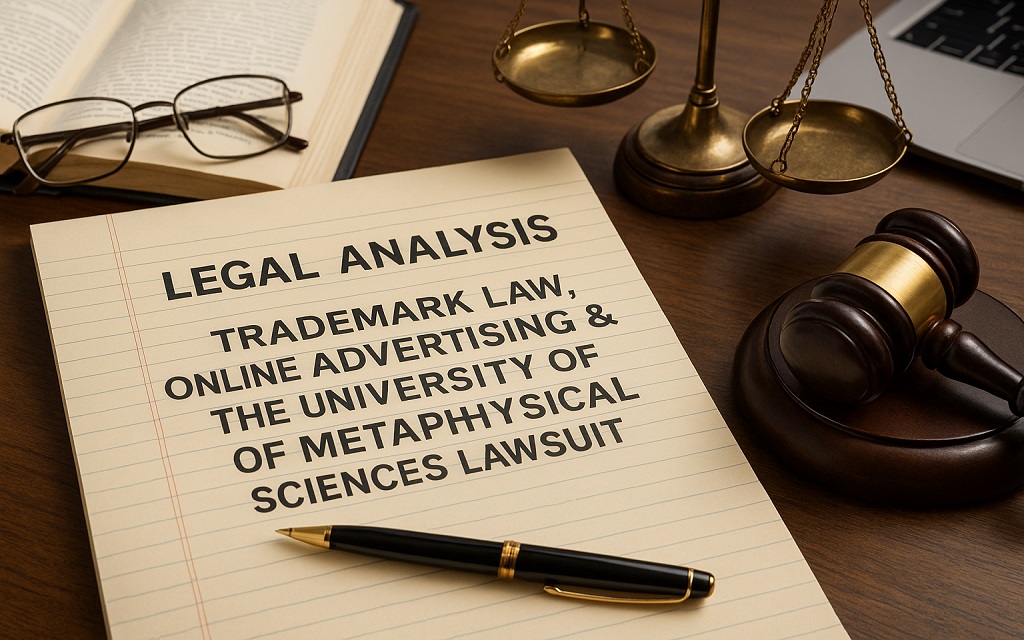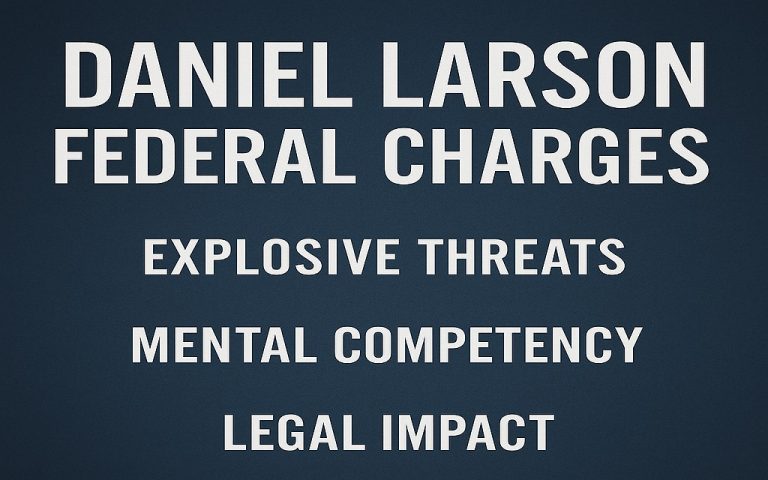The University of Metaphysical Sciences lawsuit has become a widely searched topic among students, spiritual practitioners, and researchers. People want simple answers — what happened, who filed the case, and how it ended.
This guide explains the full story behind the University of Metaphysical Sciences lawsuit, from its origins to the final court ruling. It describes how a trademark and online advertising dispute turned into federal litigation and why the case being “dismissed with prejudice” matters.
More than just a headline, the UMS lawsuit raises questions about online branding, nonprofit institutions, and the boundaries between spiritual education and business competition.
In this article, you’ll find a clear timeline, verified facts, and legal context. Let’s start by understanding what the University of Metaphysical Sciences is and how it became part of this legal battle.
What Is the University of Metaphysical Sciences (UMS)? – Background, History & Mission
Before the dispute, UMS had already built a presence in spiritual and metaphysical education. It is a non-profit, religious-exempt institution that offers online programs in esoteric studies, spiritual healing, meditation, and consciousness development.
UMS operates under Wisdom of the Heart Church, a recognized religious organization in the U.S. Because of this status, it does not follow traditional university accreditation. Instead, it provides spiritual education for personal growth rather than state-recognized professional degrees.
UMS programs focus on:
- Metaphysical healing
- Consciousness studies
- Meditation and mindfulness
- Spiritual counseling
- Holistic and ministerial training
Students enroll from around the world, mainly for self-development. However, the use of the word “university” was confused in the past, which later became part of this lawsuit.
UMS states that it does not aim to compete with traditional universities. Its mission centers on spiritual awareness, personal transformation, and higher consciousness.
As its online presence grew, it attracted attention from other metaphysical organizations — including the International Metaphysical Ministry (IMM), which later filed the lawsuit.
Understanding the role of UMS is key before reviewing the legal timeline.
Who Filed the UMS Lawsuit? – Plaintiff, Motives & Legal Background

The UMS lawsuit was filed by the International Metaphysical Ministry (IMM), an organization that also offers spiritual and metaphysical education. Over the years, IMM built recognition for terms such as metaphysical, spiritual ministry, and esoteric science.
IMM claimed that UMS’s growing online presence created confusion. According to court filings, UMS allegedly used similar keywords and branding in online advertising, including Google Ads, leading to brand overlap and potential student confusion.
Key allegations included:
- Trademark infringement
- Unfair competition
- Misleading online advertising
- Similar naming and branding
- Consumer confusion
IMM argued that students searching for their programs were being redirected to UMS, harming their reputation and enrollments. However, the case did not involve fraud or academic misconduct. It focused only on trademark rights and digital marketing practices.
UMS denied wrongdoing and stated it acted within the law, with no intent to mislead or copy another organization. This conflict over branding and visibility set the stage for multiple legal actions in the years that followed.
Case #1 – 2017: The First University of Metaphysical Sciences Lawsuit Explained
The first major UMS lawsuit emerged in 2017, when the International Metaphysical Ministry (IMM) formally filed suit. This initial case laid the foundation for everything that followed, making it one of the most critical chapters in the legal timeline.
IMM filed its complaint in federal court, claiming that the University of Metaphysical Sciences had used similar terminology, branding language, and online advertising strategies that allegedly interfered with IMM’s established identity. The main issue was not physical campuses or course material. Instead, it centered on digital presence, including website language and keyword bidding on search engines like Google.
In simple terms, the 2017 UMS lawsuit focused on three main questions:
- Did UMS intentionally use IMM-associated keywords in online ads?
- Did this lead to confusion among potential students?
- Did this give UMS an unfair competitive advantage?
IMM believed the answer was yes. They argued that people searching for their programs were being diverted. They claimed this type of keyword advertising caused financial and reputational harm.
UMS responded by denying wrongdoing. The university stated that:
- “Metaphysical” is a broad, descriptive term used by many spiritual schools
- Their branding was legitimate and not deceptive
- They did not attempt to impersonate IMM or mislead students
The court reviewed advertising data, keyword use, digital records, and legal interpretations of trademark protection. During this process, both sides presented arguments related to:
- The uniqueness or general nature of metaphysical terms
- Whether digital intent could be proven
- The actual evidence of student confusion
- The limits of trademark law in online advertising
Outcome of the 2017 Case
The outcome of the 2017 UMS lawsuit was significant. The case did not result in a ruling that UMS committed fraud or misrepresented itself as another institution. Instead, parts of the complaint were dismissed due to insufficient legal grounds or lack of evidence.
This did not completely end the dispute. However, it did weaken IMM’s initial position and forced both sides to reconsider the strength of their claims. It also set legal boundaries regarding:
- The use of generic spiritual terminology
- The limits of online advertisement disputes
- The challenge of proving intent in digital marketing practices
Although the 2017 case did not result in a final resolution, it served as the legal groundwork for future filings, negotiations, and a second round of litigation.
Case #2 – 2018: The Follow-Up UMS Lawsuit and Escalation
After the events of 2017, the legal tension between the International Metaphysical Ministry (IMM) and the University of Metaphysical Sciences (UMS) persisted. Instead, the disagreement intensified. This led to a second legal action in 2018, often referred to as the second lawsuit.
IMM returned to court with updated arguments. They attempted to strengthen their position by expanding on previous claims and introducing more detailed allegations. Once again, the key issue was trademark use, keyword placement, and online advertising strategy.
In the 2018 UMS lawsuit, IMM argued that:
- UMS continued to benefit from similar keyword targeting
- The name “University of Metaphysical Sciences” allowed for brand crossover
- Confusion still existed among students searching for metaphysical education
- Their intellectual and commercial identity was under threat
This time, the case focused even more heavily on digital activity records. Court filings referenced:
- Website metadata
- Google Ads keyword bidding patterns
- Search engine placement analytics
- Online user behavior data
IMM attempted to prove a long-term pattern of interference rather than a one-time issue. However, the legal challenge remained difficult. Terms like “metaphysical” and “spiritual science” were still widely used across multiple organizations. Proving exclusive ownership over such general terminology became a legal hurdle.
UMS defended itself again. The University of Metaphysical Sciences maintained that:
- Its name was legitimately chosen
- It served a unique spiritual mission
- No evidence showed intentional deception
- The use of general metaphysical terms was lawful
The court evaluated how trademark law applies in a niche, spiritual-education environment. It also considered the role of online marketing tools in modern disputes between organizations.
Outcome of the 2018 Case
The result of the 2018 UMS lawsuit did not produce a significant victory for IMM. In fact, the case struggled to move forward because the legal evidence still failed to meet the high standard required for trademark infringement and unfair competition claims.
Important points from this outcome include:
- No official ruling labeled UMS as deceptive
- No financial penalty was issued against UMS
- Several claims failed due to a lack of specificity
- The dispute remained unresolved, but it was legally weakened
Although no final settlement occurred at this stage, the 2018 case signaled a critical shift. It suggested that the conflict might extend beyond simple business rivalry. It also opened the door for another, more formal attempt at litigation in the following years — one that would lead to the most decisive moment in the entire UMS lawsuit timeline.
Case #3 – 2021 to 2025: The Federal University of Metaphysical Sciences Lawsuit and Final Outcome
The most significant phase of this legal action began in 2021. This time, the legal action moved deeper into the federal court system, making it the most closely watched chapter in the entire conflict between the University of Metaphysical Sciences (UMS) and the International Metaphysical Ministry (IMM).
Unlike the earlier cases, the 2021 filing was more formal, more detailed, and built around years of accumulated arguments and digital records. By this point, the conflict was no longer just about basic brand overlap. It had evolved into a complex legal question involving:
- Federal trademark interpretation
- Online keyword usage standards
- Digital fair competition rules
- First Amendment and religious organization protections
- The legal meaning of “consumer confusion” in online education markets
Many sources associate this case with U.S. District Court proceedings in California, although parts of the dispute involve activity in Arizona and other jurisdictions tied to UMS and IMM operations. What made this stage unique was the volume of evidence presented and the apparent effort to reach a final resolution.
This time, IMM focused on proving a long-term pattern. They argued that:
- The University of Metaphysical Sciences built its marketing around similar search terms
- Potential students could mistake one organization for another
- The long-term impact harmed their brand identity
- Repeated behavior demonstrated intent
In response, UMS presented arguments grounded in legal precedent. The university maintained that:
- “Metaphysical” is not owned by a single entity
- Their name is a descriptive phrase within a broad spiritual domain
- Their institution is religiously exempt under U.S. law
- No verified proof of actual student confusion existed
UMS also emphasized that the UMS lawsuit never alleged criminal activity, academic fraud, or illegal instruction. It remained a civil trademark and advertising conflict, not a case involving harmful or unlawful teachings.
The Meaning of “Dismissed With Prejudice”
The defining moment of this final chapter came when the court dismissed the case with prejudice. This phrase is crucial to the UMS lawsuit’s outcome.
“Dismissed with prejudice” means:
- The case is permanently closed
- The same claims cannot be refiled in the future
- The defendant is not required to pay damages or admit wrongdoing
- The court has made a final, binding legal decision
For UMS, this ruling represented a complete legal closure of the dispute. It meant that IMM could no longer pursue the same trademark infringement or unfair competition claims arising from this case.
Why This Final Decision Matters
The 2021–2025 phase of the UMS lawsuit carries important implications beyond both parties. It highlights modern legal challenges in the digital education world.
This case now stands as an example of:
- How difficult it is to limit the use of descriptive words in education
- The complexity of digital trademark claims
- The legal protection placed on religious and educational organizations
- The finality of a federal court dismissal with prejudice
For current and future UMS students, the ruling also brings clarity. It confirms that no legal barrier prevents the university from operating and offering metaphysical or spiritual education. It also reassures those who worried about the institution’s legitimacy or continuity.
However, the impact does not stop there.
Legal Analysis: Trademark Law, Online Advertising & the University of Metaphysical Sciences Lawsuit

At the core of the University of Metaphysical Sciences lawsuit was not a dispute about religion, belief systems, or teaching practices. Instead, it was rooted in a modern and increasingly common legal battleground: trademark law in the digital advertising space.
To understand why the court made its final decision, it is crucial to break down the legal concepts at play.
1. Was “Metaphysical” Eligible for Trademark Protection?
In U.S. trademark law, not all words are treated equally. Words are placed into categories:
- Generic terms – Cannot be owned by anyone (example: “school” or “university”)
- Descriptive terms – Hard to protect unless they gain special recognition
- Suggestive or arbitrary terms – Easier to protect
- Fanciful/invented terms – Strongest trademark protection
The word “metaphysical” is widely used across spiritual, philosophical, and educational contexts. Because of its broad and descriptive nature, the court viewed it as a weak term in trademark law.
This significantly weakened IMM’s argument. It made it very difficult to claim exclusive rights over a phrase that describes an entire field of study. That fact alone affected the direction of the University of Metaphysical Sciences’ lawsuit.
2. Online Keyword Advertising and Google Ads
Another central issue in the case involved online advertising practices, particularly keyword bidding on platforms such as Google.
IMM claimed that UMS targeted its name and related search phrases through paid ads. However, to win a case like this, the plaintiff must prove:
- The keywords were used intentionally to impersonate
- The ads caused genuine confusion
- Users could not tell the difference between organizations
- The behavior caused measurable harm
This is a very high legal standard.
UMS argued that many organizations use similar keywords in the metaphysical niche and that algorithms, not direct identity theft, drive search advertisements. They maintained that there was no attempt to impersonate IMM or misdirect users.
The court ultimately agreed that using broad or descriptive keywords does not, in itself, violate trademark law, especially when there is no objective evidence of confusion.
3. The Role of Religious and Educational Protection
Another important layer of the University of Metaphysical Sciences lawsuit involved legal recognition as a religious-exempt institution.
UMS operates under a church framework, which grants it certain legal protections. While this was not the main reason for the dismissal, it helped establish the organization’s lawful purpose. The court found no evidence of evil intent, fraudulent representation, or illegal operation.
This reinforced the view that the dispute was commercial, not criminal or unethical.
4. Why the Case Was Dismissed With Prejudice
After reviewing all legal elements, evidence, and arguments, the court concluded:
- The terms used were too broad for exclusive ownership
- The evidence of confusion was too weak
- The claims could not be strengthened in the future
- Legal standards for trademark infringement were not met
As a result, the UMS lawsuit was dismissed with prejudice, meaning it is permanently closed and cannot be refiled.
This legal outcome now stands as an essential reference point in cases involving:
- Online education branding
- Spiritual and metaphysical institutions
- Keyword advertising disputes
- Descriptive intellectual property claims
What This Legal Action Means for Students, Practitioners & Future Enrollees
For many people, the UMS lawsuit created one crucial question: Is it still safe and worthwhile to study at UMS?
Now that the case has reached a final and permanent conclusion, that question finally has a clear legal answer.
Because this lawsuit was later dismissed with prejudice on May 12, 2025, permanently closing the claims, the institution is legally allowed to continue operating without restriction from this dispute. There were no findings of fraud, illegality, or misrepresentation related to its educational programs. This outcome carries real meaning for several groups.
Current Students
If you are already enrolled in UMS programs, the final court decision brings reassurance:
- Court orders do not disrupt your studies
- Your certifications remain valid within the school’s framework
- No penalties were placed on the institution
- Operations continue as normal
The lawsuit did not challenge UMS’s spiritual philosophy, teaching methods, or core mission. Instead, the case focused purely on external marketing and branding disputes.
For students, that means this was a legal branding conflict, not a concern about the content of your education.
Future Enrollees
If you are considering enrolling, it is essential to remember:
- UMS is a religious-exempt, nontraditional institution
- It does not offer state-accredited degrees
- It is designed for spiritual, metaphysical, and personal development
- This lawsuit does not block enrollment
- The University of Metaphysical Sciences lawsuit did not result in a shutdown
Potential students can now make a clearer, more informed choice based on the court’s final ruling and the institution’s transparency.
Spiritual Practitioners & Life Coaches
Many metaphysical practitioners worried that the lawsuit could damage the broader field’s reputation. In reality, the case may do the opposite. The UMS lawsuit now stands as a legal example that:
- Broad spiritual terms cannot be privately controlled
- Competition in metaphysical education is lawful
- Institutions must focus on transparent identity
- Students should check legal and operational disclosures
This case promotes accountability and clarity across the spiritual education landscape.
What About Public Perception?
Whenever a lawsuit involves a “university,” it can raise red flags. But the final ruling helps to clear the confusion. It separates:
- Marketing disputes from actual academic misconduct
- Online advertising conflicts with ethical practice
- Legal conflict over educational quality
In short, the resolution of the UMS lawsuit can now help rebuild clarity, stability, and transparency for all parties involved — students, educators, and the broader public.
Conclusion
The University of Metaphysical Sciences lawsuit went through multiple legal phases before reaching a final decision. The case was dismissed with prejudice in 2025, meaning it is permanently closed and cannot be reopened. The court found no legal fault, fraud, or wrongdoing on the part of the institution.
This dispute was not about illegal teaching or academic misconduct. It was a trademark and online advertising conflict linked to digital branding and keyword use. The court ruled that the evidence of confusion was insufficient to support the claims.d
For students and practitioners, the outcome brings clarity. The UMS lawsuit does not affect enrollment, daily operations, or the school’s legal status as a religious-exempt educational organization. It also confirms that broad terms like “metaphysical” cannot be owned by any single group.
This case now stands as a real-world example of how trademark law applies to online education and spiritual institutions. It offers closure and a clearer outlook for the future.




